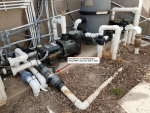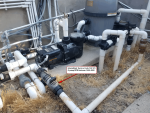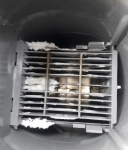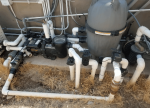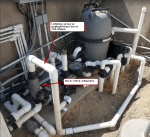I'm a little stumped at this point. All season I have been working with my pool service guys regarding a chlorine generation "issue" with our Jandy AquaPure 1400 Salt Water Generator (SWG).
New pump/filter/SWG in Spring of 2018. For the first two years I was able to run the pump at 1600rpm without getting a low salt warning (it would throw a low salt warning at 1500rpm). However, this spring the AquaPure system was intermittently throwing a low salt warning and the chlorine generation was severely lacking (had to increase the run time by 200% when getting intermittent low salt warning in order to achieve decent free chlorine levels).
However, when I increased the rpm to 2000rpm, I could go back down to the normal runtimes and would never get an intermittent low salt warning.
Pool service guy replaced the backboard, the sensor, and tried an alternative cell, but nothing had a positive effect. Below 2000rpm (possibly 1900) and chlorine generation would plummet.
After re-reading the manual I noticed the SWG cell was not properly positioned (since the original installation). It was slightly rotated so the sensor was off to the right instead of being at the bottom (see attached photos). And its not perfectly horizontal, but within 10degrees of horizontal.
So, I rotated the SWG so the sensor is now facing dowward. However, the unit is still within 10 degrees of being horizontal.
Now, since rotating the SWG cell, if I run at 1600-1850rpm I will no longer get a Low Salt Warning, but rather the service light will come on intermittently and show either a 120 or 121 code.
I figure the 10degrees off perfect horizontal is not causing the issue since its always been like that, but I am going to re-plumb it this week to achieve a perfect alignment.
Besides that, does anyone have any thoughts/recommendations? I'd prefer to operate at lower RPMs to save money on electricity out here in California, but worst case scenario 2000rpms is not terrible. I just hate knowing it worked one way for 2 years, and then needed to jump up 400rpm to work properly.
Oh, and I attached a photo of the inside of the SWG. Doesn't look like that much build up, but I just manually picked it off (instead of acid soak).
Thanks!
New pump/filter/SWG in Spring of 2018. For the first two years I was able to run the pump at 1600rpm without getting a low salt warning (it would throw a low salt warning at 1500rpm). However, this spring the AquaPure system was intermittently throwing a low salt warning and the chlorine generation was severely lacking (had to increase the run time by 200% when getting intermittent low salt warning in order to achieve decent free chlorine levels).
However, when I increased the rpm to 2000rpm, I could go back down to the normal runtimes and would never get an intermittent low salt warning.
Pool service guy replaced the backboard, the sensor, and tried an alternative cell, but nothing had a positive effect. Below 2000rpm (possibly 1900) and chlorine generation would plummet.
After re-reading the manual I noticed the SWG cell was not properly positioned (since the original installation). It was slightly rotated so the sensor was off to the right instead of being at the bottom (see attached photos). And its not perfectly horizontal, but within 10degrees of horizontal.
So, I rotated the SWG so the sensor is now facing dowward. However, the unit is still within 10 degrees of being horizontal.
Now, since rotating the SWG cell, if I run at 1600-1850rpm I will no longer get a Low Salt Warning, but rather the service light will come on intermittently and show either a 120 or 121 code.
I figure the 10degrees off perfect horizontal is not causing the issue since its always been like that, but I am going to re-plumb it this week to achieve a perfect alignment.
Besides that, does anyone have any thoughts/recommendations? I'd prefer to operate at lower RPMs to save money on electricity out here in California, but worst case scenario 2000rpms is not terrible. I just hate knowing it worked one way for 2 years, and then needed to jump up 400rpm to work properly.
Oh, and I attached a photo of the inside of the SWG. Doesn't look like that much build up, but I just manually picked it off (instead of acid soak).
Thanks!
Attachments
Last edited:


